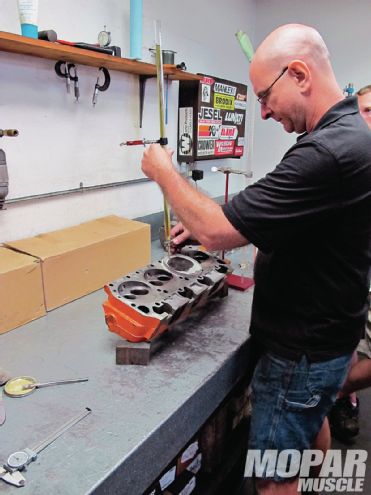
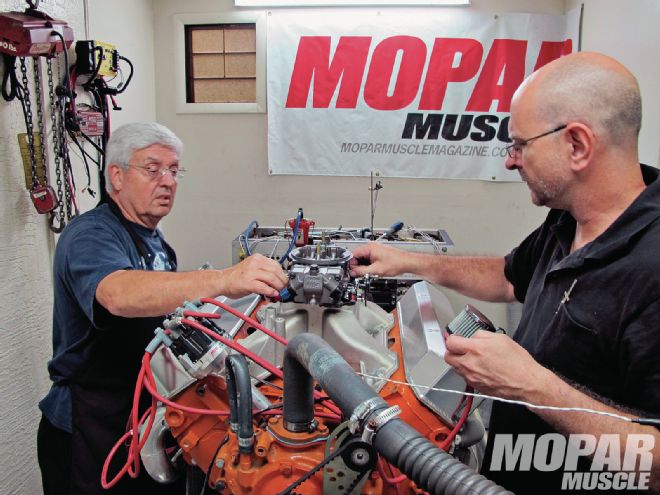 When it comes to powerful engines, size does matter. So by starting with the largest V-8 Chrysler built, a simple build is all it takes to make great power and torque.
When it comes to powerful engines, size does matter. So by starting with the largest V-8 Chrysler built, a simple build is all it takes to make great power and torque.
We all know the 440 big-block is the largest displacement V-8 engine built by Chrysler, and when it comes to a combination of torque, power, and drivability, the 440 ranks as one of the best engines ever built. Instead of utilizing a high compression ratio or aggressive cam grind for its muscle, the 440 relies on sheer size, making great power from an idle with enough torque to get even the heaviest Mopar C-Body moving quickly. And while the Mopar 440 does several things very well, we've always felt that with a few tweaks the engine was capable of well over the 375 horsepower rating it got from the factory.
The 440 is definitely a versatile engine, having been installed in Mopar passenger vehicles from muscle cars to station wagons, in trucks, and even in boats. Even the highest performing factory 440, the 390 horsepower Six-Pack (or Six-Barrel) version, had a relatively mild hydraulic flat-tappet camshaft and non-adjustable rocker arms, ensuring years of smooth, maintenance free operation. Even better, 440s are still available in scrap yards, from core suppliers, or even in running vehicles if you know where to look.
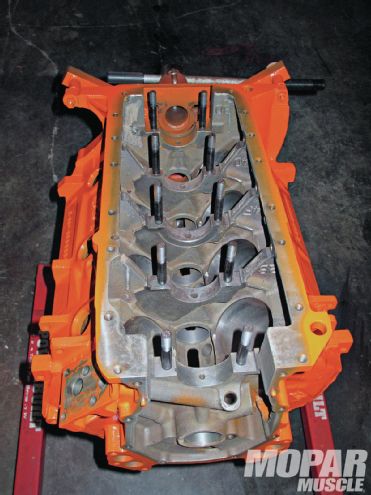 1. The 440 we’re using for this build came from a low mileage motor home, and showed very little wear once disassembled. For a little extra durability we added ARP main studs, but otherwise the block was simply cleaned and then honed to break the glaze in the cylinders.
1. The 440 we’re using for this build came from a low mileage motor home, and showed very little wear once disassembled. For a little extra durability we added ARP main studs, but otherwise the block was simply cleaned and then honed to break the glaze in the cylinders.
The 440 we're featuring in this build was actually in a low-mileage Winnebago motor home that was built on a '74 Dodge truck chassis. We found the engine in the local classified ads, and bought the engine and transmission from the owner for a paltry $400.00. The motor home had seen better days and was being scrapped, so the owner simply had no use for the engine any more. As an added benefit, this engine (like many early to mid-seventies truck and motor home 440s) was equipped with a factory forged crankshaft. So when we needed an engine to build as a dyno mule to test some parts, this 440 fit the bill nicely. Even better, the engine had very little wear so it wouldn't need much in the way of machine work.
Many engines used in motor homes now have high-mileage and are completely worn out, but some motor homes, especially older ones, didn't see much use. The motor home our engine was in only showed some 40,000 miles on the odometer, and was only used once or twice a year for family vacations. When we disassembled this engine we found that all of the internals were standard, and the cylinder bores were still round and straight without any ridge at the top. Since we had a set of older, standard bore Speed Pro forged, flat-top pistons on the shelf we acquired years ago at a swap meet, this engine was the perfect excuse to keep our pistons from collecting any more dust.
The only downside to using our Speed Pro pistons was that the compression of this engine with the stock heads and the pistons .014-inch down in the bore at TDC, would only be around 9.0:1. Since a 440 with compression this low wouldn't make enough power to impress anyone, we took the opportunity to use a set of “915” casting cylinder heads that were also sitting on a shelf in our shop. We had picked these heads up years ago at a swap meet as well, paying only $100 for the pair. After cleaning the heads up we cut the exhaust seats and installed a set of stock exhaust valves from some 906 heads, a set of Comp 928-16 valve springs, and performed a simple port-match job and valve job to make them serviceable. With a closed chamber design and a measured chamber volume of 82cc's, we calculated the static compression of our 440 using the 915 heads to be 10.18:1, so our 440 will run great on pump gas.
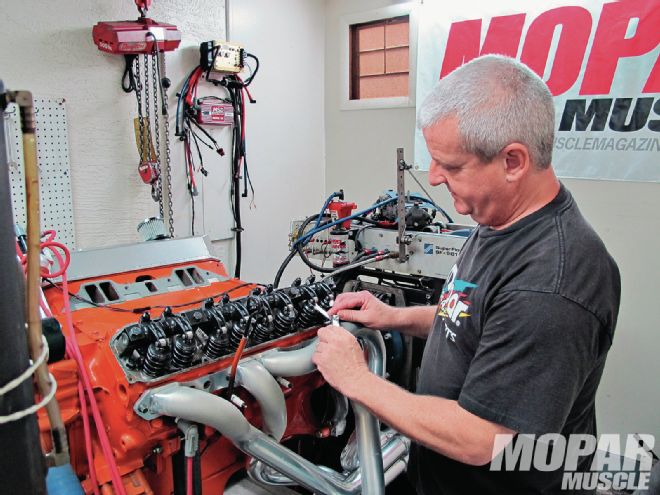 5. Comp Cams supplied the valve train and timing set for this engine. Solid lifter cams can improve power, torque, and throttle response, and don’t cost any more than hydraulic cams. When used in a big-block Mopar, however, they do require the added cost of adjustable rocker arms.
5. Comp Cams supplied the valve train and timing set for this engine. Solid lifter cams can improve power, torque, and throttle response, and don’t cost any more than hydraulic cams. When used in a big-block Mopar, however, they do require the added cost of adjustable rocker arms.
For the rotating assembly of this engine, we simply polished the crankshaft, installed ARP rod bolts and main studs, and new stock replacement engine bearings from Summit Racing Equipment. We fitted our Speed Pro pistons with stock rings, and sealed the engine with a fresh set of gaskets and seals, also from Summit. As you likely can tell, we're building this 440 on a budget, and simply replacing the parts necessary to make it perform properly and last, but not going over the top with any lightweight or exotic pieces. Using a new Melling oil pump with a factory B-Body HP oil pan and windage tray also keeps things inexpensive, but works just fine for an engine like our mild big-block.
One area where we will definitely upgrade our 440 is with a new camshaft and lifters from Comp Cams. To enhance the power of our big-block, we chose a Comp PN 23-362-5 solid flat-tappet cam and lifter kit. This cam isn't small by any means, but isn't a giant either with .567-inch intake lift, 264 degrees duration at .050-inch lift, and a lobe separation of 108 degrees. This cam is what we consider an aggressive street/strip grind, and should wake up our otherwise stock 440. To spin the camshaft, we chose a Comp double roller timing set.
 6. We had Kevin at APE cc the chambers of our 915 heads so that we could calculate the compression of this engine accurately. At 82cc’s, our 440 has 10.18:1 compression and will run great on pump gas. These stock heads were also treated to Comp 928 valve springs, port matched on the intake side, and cut for exhaust valves from a set of 906 factory heads.
6. We had Kevin at APE cc the chambers of our 915 heads so that we could calculate the compression of this engine accurately. At 82cc’s, our 440 has 10.18:1 compression and will run great on pump gas. These stock heads were also treated to Comp 928 valve springs, port matched on the intake side, and cut for exhaust valves from a set of 906 factory heads.
Of course since we're upgrading to solid lifters, we also need to install adjustable rocker gear, so we installed a set of Comp's Ultra Pro-Magnum adjustable roller rocker arms. The Ultra Pro-Magnum rocker kit comes with the rocker arms, adjustors, new shafts, and the necessary spacers. We've used these rockers before and found them to be some of the best rocker arms on the market for the price, and like the fact that the Comp rockers utilize ball-ball type pushrods. These parts might be overkill for what we're building, but the durability makes it worthwhile.
For induction, we will use an older Mopar Performance M-1 aluminum single-plane intake manifold that we picked up at the Mopar Nationals swap meet. The intake was priced so well, that we couldn't pass it up. Topping the M-1 intake, we'll install a new Holley Ultra HP 950 cfm double-pumper carburetor. This carb is actually the most expensive single part we're installing on our engine, but will greatly ease tuning while the engine is on the dyno. In our experience the Ultra HP series of carbs from Holley perform flawlessly right out of the box, needing very little tuning just to match the carb to the particular engine.
With the engine on the dyno at Auto Performance Engines (APE), we bolted on a set of APE's Hooker Super Competition dyno headers and an MSD pro-billet dyno distributor. We like the MSD distributor because it makes changing ignition timing curves easy, though for cost considerations a Chrysler electronic distributor would also be sufficient for this engine. For testing purposes, using the known good headers and distributor provided by APE ensure we won't have any issues while tuning this engine.
Prior to firing up our 440, we poured in six quarts of Comp Cams 10W30 break in oil and primed the oil system. Flat-tappet camshafts require special lubricants to break in properly, and Comp's oil contains the necessary additive package to ensure our cam performs properly for the life of this engine. After starting the engine and running it through a break-in cycle, we let it cool down, double checked valve lash, and were ready to make some test pulls.
After making a couple of ignition timing changes, we found our 440 to like 37 degrees of total advance, and the air/fuel ratio of this engine was nearly perfect with our out-of-the-box Holley 950. Our peak power with this combination was 460.6 at 6,000 rpm, and peak torque was a stump-pulling 466.9 lb/ft. As we further develop this combination, we'll optimize our 440 by testing a variety of parts on the engine. For now, however, we're happy to have made a whole bunch more power than a factory 440, while sticking to a very conservative parts budget.
Our big-block dyno engine will actually serve several purposes for us here at Mopar Muscle. First, this 440 shows our readers that the right combination of a few aftermarket parts, built with a conservative budget, can make plenty of power to make any Mopar fun to drive. Next, this engine will be a test mule of sorts for future articles, as we'll use it for intake manifold, carburetor, and cylinder head testing for starters. Be sure to check out our website for additional photos and for video of this engine making dyno pulls, and look for future articles as we use this engine for additional testing.
Price Tag Used 440 with forged crank from motor home $400.00 915 Heads from swap meet $100.00 Basic machine work, gaskets, oil pump, and bearings $1,250.00 Used Speed Pro PN 2355F forged flat-top pistons $125.00 Comp Pro-Magnum roller rocker arms $679.95 Comp Cams flat-tappet cam and lifters $225.95 Comp 928-16 valve springs $158.95 Comp double-roller timing set $47.95 Mopar Performance M-1 intake from swap meet $175.00 Holley Ultra HP 950 carburetor $810.00 Total cost of build $3,972.80 Cost per horsepower $8.63
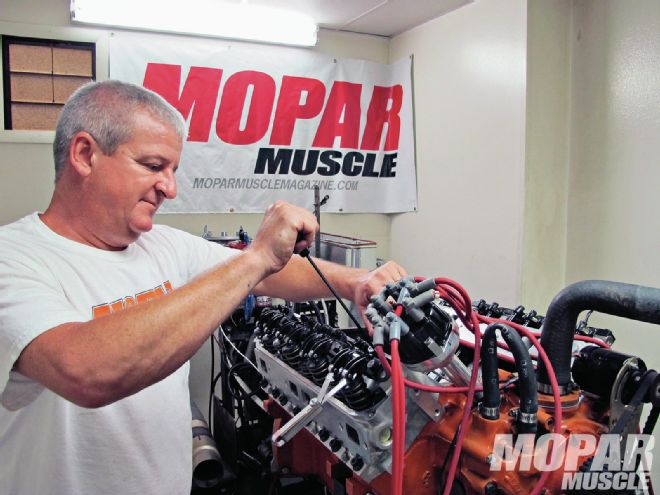 13. We’re just getting started with this budget built 440 engine, so be sure to watch future issues for more testing. We’re already planning an intake manifold shootout, and will likely use this big-block for some cylinder head testing as well. Visit www.moparmuscle.com to let us know what parts you’d like to see us test on this big-block.
13. We’re just getting started with this budget built 440 engine, so be sure to watch future issues for more testing. We’re already planning an intake manifold shootout, and will likely use this big-block for some cylinder head testing as well. Visit www.moparmuscle.com to let us know what parts you’d like to see us test on this big-block.